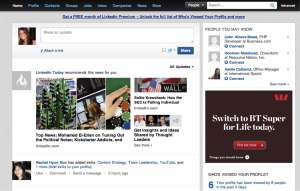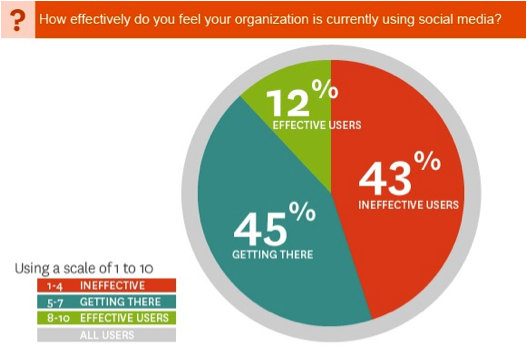Erik Qualman's Blog, page 650
October 29, 2012
Is the New LinkedIn Layout a Success?

 It has officially been a little over one month since the launch of the new LinkedIn design, so naturally it’s time to do what business loves most: analyze. Although none of the changes were too dramatic, they were distinct enough that people noticed and had to stop and do a little bit of troubleshooting. We’ve seen many different social networks change their layouts and the way things work, so it’s natural to ask that inevitable question: Were the LinkedIn changes really for the better, or was this just another social network trying to keep things fresh?
It has officially been a little over one month since the launch of the new LinkedIn design, so naturally it’s time to do what business loves most: analyze. Although none of the changes were too dramatic, they were distinct enough that people noticed and had to stop and do a little bit of troubleshooting. We’ve seen many different social networks change their layouts and the way things work, so it’s natural to ask that inevitable question: Were the LinkedIn changes really for the better, or was this just another social network trying to keep things fresh?
The LinkedIn Changes Explained
If you haven’t seen the changes or haven’t bothered to figure them out over the last month, don’t sweat it. You’re missing just a few major differences from the old LinkedIn:
Relevant articles to the top. In the past your articles came up to the top of your feed as they came through, but now LinkedIn will help determine what is the most relevant to you. By looking at your connections and the content that you’re sharing on the network, they do a pretty good job.
Feeds help you stay informed. In a Facebook-like fashion, the network now has a feed that will show you each time someone updates his/her LinkedIn page.
Although the changes might not seem overly dramatic, it’s really the look of the page that has changed more than anything. Below is a screenshot of the new layout:
As of now, all old LinkedIn profiles should be changed to the new layout.
The Pros of the New LinkedIn Layout
The overall consensus online seems to be positive amongst individuals as well as business. Below are a few of the benefits of the new layout:
News is more accessible and relevant. Because the network decided to place relevant news results on top and feature them at the top of the screen, users are more likely to want to click and read.
The layout is modernized. This means that things such as the profile photo as well as a more prominent summary section. Both of these aspects are usually important to employers, so the changes make sense.
Notifications. LinkedIn will now send you little blue flags to notify you if someone does something that affects you (accepts a connection, sends you a message, etc.).
Event Recommendations. You can actually type in a city into the search bar and a list of events going on in that city will come up. Great for travelers, giving LinkedIn yet another use.
Endorsements. This new feature is a great way for your connections to vouch for you without having to create a long and involved recommendation. Once you update the skills that you have, your connections can endorse you, putting their picture right next to the skill you posses.
In terms of things that were taken away to benefit the network—the Twitter feed. Everyone wanted Twitter to be Twitter and LinkedIn to be LinkedIn, and now it finally is.
Where the New LinkedIn Layout Didn’t Deliver
Many of the negatives to the new layout occur in the profile section. Point blank, there isn’t quite as much on the top of the page as their used to be. Although the summary section and profile picture are larger, information such as past work experiences and web addresses are now hidden.
The biggest issue, however, that individuals have with the new LinkedIn is the thought that it is looking more and more like Facebook—and I have to say I agree. With the whole idea of a “feed” and always knowing when there is a change in someone’s life (professional life in the case), this really is extremely similar to our social networking giant. This type of layout only seems to add to what many their “obsession” with any given website, whereas in the past LinkedIn was one social network that allowed users to bypass the obsessive and move straight to the productive.
Are you a fan of the new layout? What do you think still needs improvement (or should have never been changed in the first place)? Let us know your thoughts in the comments below.
Photo Credit: articles.timesofindia.indiatimes.com
[image error]
October 26, 2012
Harnessing Social Proof: The Most Persuading Type Of Testimonial

 Testimonials are one of the most powerful ways to boost online credibility and harness social proof. Usually showcasing first-hand examples of happy customers, testimonials provide supporting evidence from third parties that lend credibility to what you’re offering.
Testimonials are one of the most powerful ways to boost online credibility and harness social proof. Usually showcasing first-hand examples of happy customers, testimonials provide supporting evidence from third parties that lend credibility to what you’re offering.
Some types of testimonials, however, are more powerful and persuading than others. Research shows that testimonials written out in plain text raise your chances of obtaining a sale by 18%. A testimonial that uses audio or a combination of text and audio raises that chance just over 30%. Websites that use video testimonials are over 56% more likely to get a sale than ones that use the other types.
So, what makes video so effective?
For starters, video is difficult to fake. Let’s not forget that certain software programs, available over the Internet for free, make it way too easy to manipulate audio testimonials. Several recordings by the same person can be easily modified so that it sounds like each sound byte is coming from a unique individual. And we all know that anyone can write up a few lines of text and wrap a few cleverly designed quotes around it.
A video offers true credibility. Humans tend to be emotional, and making an emotional connection through video increases believability and credibility. You can sell through text and audio until you’re blue in the face, but for a prospect to actually hear and see someone else vouch for your product or service greatly boosts credibility and increases your overall chance of closing a sale.
A video is ultra-persuasive. When prospects see a video testimonial, they feel like they’re being approached on a personal level, with similar interests and needs, instead of watching some marketing guru with a snazzy sales pitch. In fact, in 2009 Nielson reported that 90% of people rely on recommendations from those they personally know, and a whopping 70% trust recommendations posted by total strangers.
Hands down, video testimonials are one of the most effective ways to socially persuade potential consumers into investing in your products or services. Videos allow prospects to see – and hear – about another client’s experience. This not only improves your chances of getting the sale, but it also assists in building a better relationship with your customer – which could ultimately lead to an increase in repeat business as well.
[image error]
October 24, 2012
The Age of Social Customer Acquisition Has Arrived
As the social media landscape has evolved, so too have the tools that exist to help busy marketers manage it. Luma Partners and Buddy Media, pre-acquisition by Salesforce.com, released a 2012 snapshot of the social media landscape that rapidly went viral:
To date, brands have been able to successfully harness the power of social media to improve company awareness. But one segment has been largely underserved, particularly in the small and mid-sized business market, until recently: social customer acquisition.
How is social customer acquisition being addressed now?
To acquire social customers at scale, small and mid-sized business need to turn to technology vendors. Existing options from leaders Oracle, IBM, Google and Salesforce.com are, for the most part, not accessible to that market, according to a recent 451 Research report, Has social customer acquisition emerged as a stand-alone market.
What small and mid-sized companies need are technology solutions that include a four-pronged approach that encourages listening, engagement, action, and measurement, at an affordable price. At the core of scaling social customer acquisition for this market is the ability to identify likely buyers of products and services, unhappy customers of competitors’ products, and current customers ripe for an up-sell opportunity.
As Martin Schneider from 451 Research points out, the scalable and enabling factor for such technologies lies in social profiling. Social profiling allows companies to identify and segment different groups of potential buyers, and then tie important demographic and social activity data to the company’s CRM or marketing automation stack. Once the datasets are merged and automatically de-duped, then highly targeted marketing can begin in earnest. The idea behind this is simple: collected social profile information, a combination of demographic and social activity data, can reveal valuable insights about an individual’s behavior across channels. This insight can then help marketers unravel intent to purchase or signals for customer defection. At the same time, a company can put triggers in place to jump on hot leads or salvage potential lost revenue.
As part of the report, Martin provides a detailed look at how leads the space:
Part of the social profile magic comes from having the ability to segment and score social leads, similar to the ways marketers have traditionally approached lead prioritization in a traditional lead generation setting. As each business is unique, the ability for small and mid-sized business to create their own social scoring logic becomes the make-or-break way for them to navigate the social web for social customer acquisition at scale.
What is important, as the 451 Report highlights, is the opportunity that social profiling holds for traditional CRM. Imagine, for a minute, that a company can use the insights gleaned from customer social activity to identify their true brand advocates – those customers who not only buy from your business, but those who go out of their way to support your brand and products. Small and mid-sized businesses would then have the ability to offer these customers exclusive offers and specials that not only keep them in the fold, but uses the power of these customers’ social networks to bring new customers in. At that point, the old marketing adage that ‘half of all marketing spend is wasted, but we just don’t know which half’ becomes a way of the past.
We may be a long way off from turning businesses into full social enterprises, as Martin posits, but we have certainly arrived at the point where social customer acquisition is not just talk for small and mid-sized business – it is being used by a growing number of businesses, who know they need it.
[image error]
October 23, 2012
Six Keys to Standing Out on the Social Web [Infographic]
The latest research by Napkin Labs shows that only 6% of a brand’s Facebook fans engage with that brand’s page. What can you do to increase that percentage and effectively engage your Facebook audience? I answer this question and more in my new book, Stand Out Social Marketing: How to Rise Above the Noise, Differentiate Your Brand, and Build an Outstanding Online Presence.
Check out the infographic below for six key ingredients to successfully stand out in social media. And don’t forget to order Stand Out Social Marketing, hitting shelves on November 9th, formore strategies and tactics to help you differentiate your brand online!
Marketers, what tactics do you use to stand out on the social web? Tell us on Twitter at @awarenessinc.
[image error]
October 22, 2012
Mobile = Harmony

A century ago merchants located their stores on main street because that’s where the customers were. A half century ago they started consolidating and moving to super stores and/or malls. Well, “times they are a chang’n” again but this time we’re going mobile. Mobile retail is up to almost 4% of all retail even though virtually no local merchants even have a mobile presence where consumers can shop or buy. Most merchants I’ve talked to about this phenomenon dismiss it but the simple fact is that they are going to have to change. Main street is going away again and their customer bases are already starting to dry up. Mobile is here to stay and will provide a huge oppotunity for SEO and Social Media consultants and service providers because this new mobile centric world is going to expand their customer base to include every business and government bureaucracy on the planet.
And here are some of the key functionalities I feel are driving this mobile explosion.
1. Smart phones will replace credit cards – I know, I know. Square has that neat little thing that attaches to smart phones and you swipe the card but this is temporary. Eventually Square transactions will be “click to pay”. No credit card required. The financial infrastructure that will eventually replace the Credit Card exchange is already starting to form.
2. Mobile search will totally replace the yellow pages – Virtually all business search will soon be done on the mobile. It will be Google Places, Yahoo Local, and/or Bing Business Portal. I personally think Google Places will prevail but all offer mobile optimized search. The rapid switch to these new mobile yellow pages will be a huge opportunity for Social Media and SEO service providers and consultants to offer products and services that move businesses from the old main street to the new main street.
3. Every business will soon have a mobile storefront – They may or may not have a brick and mortar storefront but Social Media, SEO, Design, and Web Dev professionals are going to stay very busy working with businesses to spec out this new mobile centric main street and to make sure that each storefront is optimized for maximum return.
4. Mobile = Harmony – All these new storefronts will, of course, allow consumers to quickly send in orders for and pay for products and services but they will also offer functionality that goes far beyond what any storefront has ever been able to offer before.
a. Businesses will now be able to Capture, Track, and Engage with all their customers not just the ones who are gabby or the 2% that fill out feedback forms.
b. Tools are being developed as I write that will allow Place pages, web pages, mobile devices, text messaging, traditional talky phones, coupons, analytics, geo-location, QSR, SEO, SEM, social media campaigns, coupon initiatives, etc., etc. to be coordinated in a manner that maximizes each merchant’s unique customer acquisition and customer retention efforts and initiatives.
c. The new mobile storefronts will ultimately even allow businesses to start integrating commercial activity originating from customer mobile devices with other business tasks like bank loan applications, accounting, and government reporting. This will mean a lot less time in the back room doing paperwork and a lot more time up front with customers.
Yes, Mobile = Harmony and harmony is on its way.
[image error]
October 18, 2012
How Social Media Is Transforming Insurance Company Practices

At Socialnomics, we’re always writing about the enormous impact of social media on so many aspects of our daily lives. Recent posts have shown the importance of using social media for a company’s business sales, its online business reputation and even one’s TV entertainment.
But here’s a new twist – have you ever connected social media with insurance? Sure, it’s not top of mind, but more and more social media users are using online images, blog posts and video clips to make their own case for an insurance claim, even before an insurance inspector shows up.
Because of the immediacy of posted digital images and video clips, and the accessibility of reaching out to insurance companies via social media, the insurance industry has stepped up its game to become more social. Trade publication Business Insurance notes that insurers are using social media for company branding and marketing purposes, but more frequently they’re using it in claims work for bigger advantages.
“Insurance companies have long leveraged social platforms for marketing and brand building, but now they also are finding that social mediums furnish a bounty of data that can be used to improve the underwriting and claims process,” the publication writes.
The advantage of using social media can work both ways, both to the benefit of the claimant and to the benefit of the insurance company. For instance, if you’ve just been involved in a car accident, you should definitely use your smart phone device to take some pictures, and use your voice recorder to describe the event that just unfolded. Having just been in a car accident a few months ago, I can assure you that having the images uploaded to the online claim filing system for my car insurance company helped my claim move forward quickly in my favor.
But conversely, insurance companies using social media can check the validity of claims in a type of surveillance scenario. Business Insurance notes an example where fraudulent claims can be uncovered by careless workers’ use of social media. For example, an insurance agent noted that a warehouse worker who filed a claim for an injured arm wrote on his social media about playing a rock show that upcoming weekend as a guitarist. After checking the guitar player/injured warehouse worker’s advertisement for the show on Myspace, the insurance company’s investigator took pictures of the fraudulent worker and subsequently denied the claim.
Social media helps out insurance companies too, by lowering their marketing costs. Most insurance buyers find insurance companies on the Internet, seek out prices and policies, and then use that arsenal of information to work with a local agent or broker to actually buy the policy. This tends to happen more with complex life insurance products, or commercial casualty coverage, rather than more straightforward auto insurance purchased online.
Using social media allows consumers to get quick responses to questions and easier price comparisons between insurers. Plus, they can use social media to reach out to friends and seek advice, recommendations and more to better assess which insurance plan might be right for them. After all, being social on social media is half the enticement.
Likewise, insurance companies that are active on Twitter, Facebook, Reddit, Quora and other social information sites can transform insurance marketing language into easy to understand points for consumers. And that will lend itself to bringing in more customers in the long term, so the business demand to satisfy consumers online is becoming an important daily work task for insurers.
Twenty-somethings looking to buy vehicle insurance or life insurance for the first time aren’t going to call a local insurance agent. They will go to Google search, find insurance policies and prices online, and probably ask their parents a question or two and then press click. That’s how it works for young social media users.
With younger generations reliant upon social media as their favored form of communication, the future will most likely include more direct selling to end-user customers via these new distribution methods. Insurance companies should be quick to implement new programs that incorporate
– text messaging for fast responses to a company text service;
– social media inquiries from hashtags about seeking insurance;
– answers to a Facebook page inquiries;
– using smart phone apps to allow for mobile sales.
These marketing initiatives would help bring the insurance company closer to its users and help to lower their overall costs of printing and mailing costly pamphlets and marketing materials to people’s homes.
Other tips that emerge for insurance companies using social media come in the way of smart phone apps. One look around Android Zoom and you’ll see that insurance apps are plentiful for consumers to use in case of claims or car accidents. One growing space is Insurance companies creating apps with social media that could enable claimants to file claims immediately after an event. Photos taken on the spot could be submitted through an app, and payments could be directly credited to the claimant’s account.
The future is here and now. Some insurers are already moving in this direction, others are hesitant about such a sudden change in company practice, and others will likely be slow to work with social media as a preferred communications voice. Those companies may not exist in future years, so they should definitely look into social media to communicate/connect with their customers.
[image error]
Takeaways from Vocus’ SMB social media survey: Success, but room for improvement

Small and medium sized business, a segment responsible for up to 50% of our GDP, is well-poised to shake things up in the social space. Duct Tape Marketing partnered with Vocus, a provider of cloud-based marketing and PR software, to conduct a survey of 400 marketing SMB decision-makers. The results provide interesting data on the amount of money invested in social endeavors, how SMBs use social, and their success metrics.
Image 1: According to HBR, 88% of companies don’t believe they currently use social media effectively
Resources invested in social media
Contrary to the popular belief that social media is a “free” form of marketing, SMBs spend an average of $845/month and 25% or more of their marketing efforts on social media. This indicates the continuing growth of social as companies develop more comprehensive strategies and merge paid, owned, and earned media into converged media.
How are SMBs using social media?
Out of the resources dedicated to social, push marketing currently holds the greatest share of brands’ effort, with 90% of brands sharing company and product news and 80% promoting posted content. Push tactics do not encompass the full potential of social, which can be used successfully for recruiting, customer support, and two-way value creation.
One enormous opportunity
Four in ten brands don’t engage in one-on-one discussions with customers. If a customer tries to engage and is ignored, that brand has lost an opportunity to create value, not to mention the possibility of creating customer advocacy. More importantly, according to Carol Rozwell of Gartner, failure to respond to customers on social networks can lead to up to a 15% increase in the churn rate of existing customers.
Image 2: SMBs push more often than pull, and miss out on potential value from social
How do SMBs measure social media success?
SMB marketers continue to measure success as increased traffic to company websites, referral traffic, and number of ‘Likes’ and followers. These metrics have a heavy slant towards measuring social as a sales or referral tool, which ignores its many other benefits. In addition, sales-focused metrics fail to measure actual conversion rates and product sales coming from social, which are more important than total website traffic and other measurements not directly relevant to revenue.
Image 3: Most SMBs rely on sales-focused metrics over engagement metrics
One major failure with current SMB success metrics is the lack of tracking the number of conversations happening in social – 58% of companies are not tracking the number of conversations, which means they aren’t closely monitoring engagement with their brand. The potential of social extends far beyond direct sales!
The cost of not planning a social strategy
Social can no longer be ignored, and companies need to create a full-fledged social strategy. An SMB Group study discovered that companies using social as part of a “planned corporate approach” were up to two times more likely to experience revenue growth than companies lacking a comprehensive plan.
You can’t afford to ignore social, and you can’t afford to dive in without a plan. For more information on the state of social marketing, download our latest white paper here,which surveyed over 450 marketers from companies of all sizes.
[image error]
October 17, 2012
Social Media Offers Business and Consumer the Right Credit Cards

It seems that turning to social media can help you find just about anything these days.
For those consumers looking for the right credit card offers, they need look no further than Facebook, Twitter, Pinterest and the other major social media venues.
Why you may ask?
According to data from The Economist, close to 80 percent of U.S. businesses are composed of less than 10 people, meaning those who run small companies account for a large portion of entrepreneurships nationwide. As a result, they are challenged with discovering and implementing cost-effective means to grow their companies.
One such way to do that is putting social media to work for their brand.
Along with the recognition that comes with advertising the services you offer customers, including accepting credit cards when shopping, social media gets your brand out in the spotlight.
Whether it is Facebook, Twitter, Pinterest or another SM venue, current and potential customers oftentimes will promote your small business simply by telling their family and friends about it. Through shares and tweets, you essentially get free advertising.
In order to capitalize on what social media can offer your small business, be sure to:
1. Use plug-ins on your company site that promote social media sharing;
2. Have your employees, family and friends promote your business pages, however make sure it is done in a professional manner so that the integrity of your business is never compromised;
3. Promote your social media pages regularly so that you not only get the attention of consumers, but also stay in the good graces of search engines. The more action on your pages, the better chance of having search engines raise your profile;
4. Reward those individuals (see more below) who are regulars to your social media pages. Such rewards can include discounts for products and services, along with discounts on credit card applications to shop with you.
As it relates to rewarding customers, you will likely make available additional upfront perks to entice people to want to do more business with you.
In many cases, a credit card company will team up with a retailer, offering a discount for those individuals open to making purchases at the business using the company’s credit card. As a result, the business receives some free advertising, while the credit card provider acquires added income through the processing charges.
As 2012 winds down, it should be noted that the credit card industry has been spending more time and resources embracing social media in order to communicate with and let customers know about what they are up to.
For the cardholder, they can now interact with the company via social venues and receive up to date details and deal notifications minus having to visit countless websites.
In the end, the cardholder, the card provider, and the small business in a relationship with the credit card company all win.
Photo credit: capitalprocessingnetwork.com
[image error]
9 Must-Follow Twitter Feeds for Surviving College Life

College life is hard. Classes, parties, and financial aid can go from happiness to headache in a heartbeat. But if you’re an active social media user, you can navigate your education easily if you read the right news. Don’t know where to start? Don’t worry. We’ve got you covered. From financial aid to funny, here are nine must-follow Twitter feeds for surviving college life.
@YourSchool

If you’re going to have Twitter and be in college, you need to follow your school. You’ll stay abreast of campus news, inclement weather updates, and learn who else on campus tweets.
@HuffPostCollege

The Huffington Post bills itself as the Internet newspaper, and this is a live feed into its college section. If you love college life or you have interest in universities, stay informed with frequent updates and great articles.
@NYTEdLife

The education section of The New York Times can sit squarely in your news feed. With lots of links to fantastic resources and advice for college life, you can easily join — or simply read — the conversation.
@OurCollegePlan

This Twitter feed is great for college planning, including tricky financial tips and hints for life. They retweet lots of relevant articles, as well. It’s a one-stop shop for all your college planning needs!
@HerCampus

HerCampus is like an online magazine for women in college, featuring lifestyle, love, fashion, and education-themed updates. Even if you’re not a young co-ed, you can find some great tips for surviving your university years here.
@UniversityLink

It’s a magazine about college, written by college students. Here, you’ll find lots of relevant celebrity interviews and updates about college life. And if you’ve got the writing bug, you can submit your own work, too.
@CollegeBlender

College Blender is a Twitter feed for those looking to increase and deepen connections between college life, professors, and students. And they’ve got a sense of humor, too!
@CollegeHumor

Speaking of a sense of humor, if you need a laugh, follow CollegeHumor. Even if you’ve never darkened the door of an institute of higher learning, their Twitter feed and website will have you in stitches!
@YourMajor

Majoring in philosophy? Finance? Sociology? Whatever your chosen field of study, you should follow relevant feeds. If you’re majoring in journalism, education, business, or political science, you won’t be at a loss for reading Tweets. There’s a ton of free information about the thing you think about all day — find it, follow it, and use it for good.
[image error]
October 16, 2012
State of Social Marketing Survey [Infographic]

What do 469 marketers from a wide variety of industries and company sizes, plus a range of social marketing expertise have to say about the state of social marketing? As we look ahead to 2013, where will marketers invest their resources? Where will they look to expand their presence and offering? What will they name as their top challenge?
Take a peek at our infographic below and read the full survey results in our free paper The State of Social Marketing Reports: 7 Major Findings & In-Depth Analysis.
Do you agree? Is ROI measurement the top social marketing challenge in your organization? Tell us on Twitter at @awarenessinc.
[image error]












